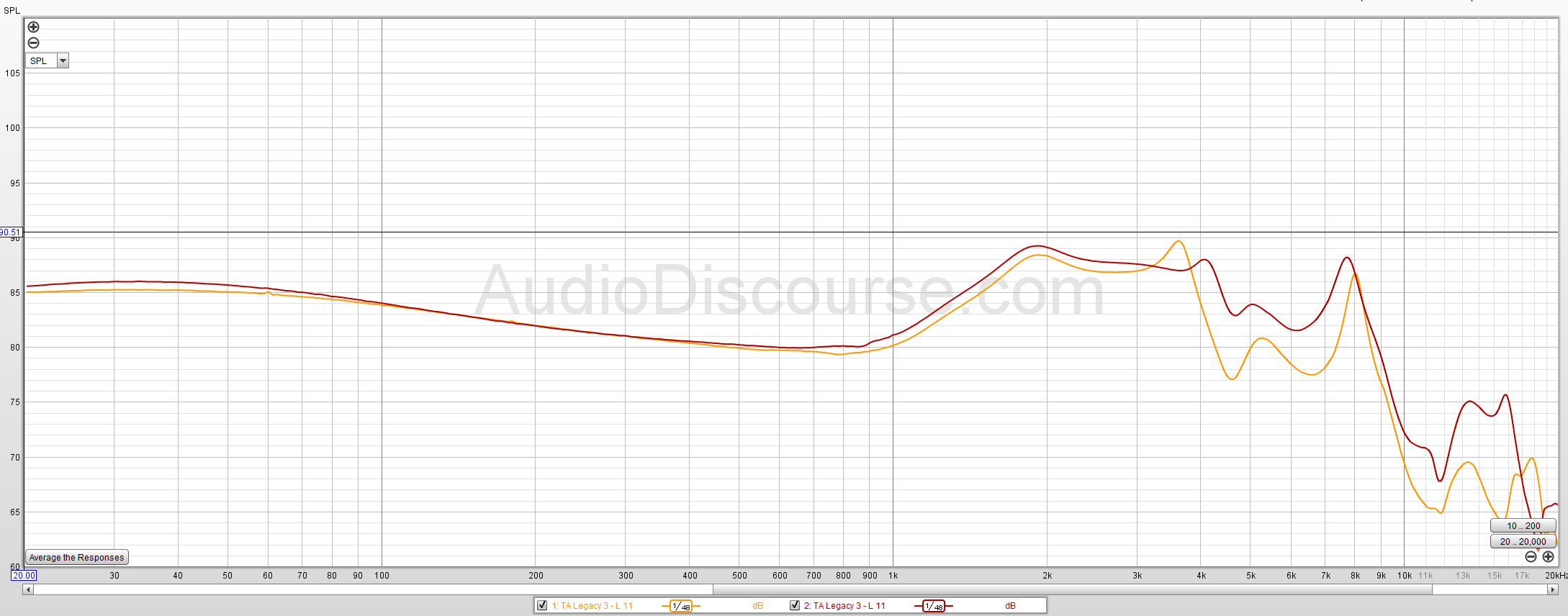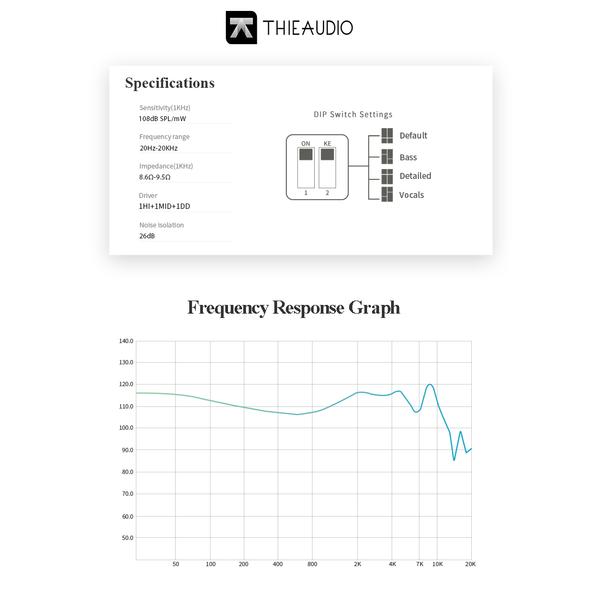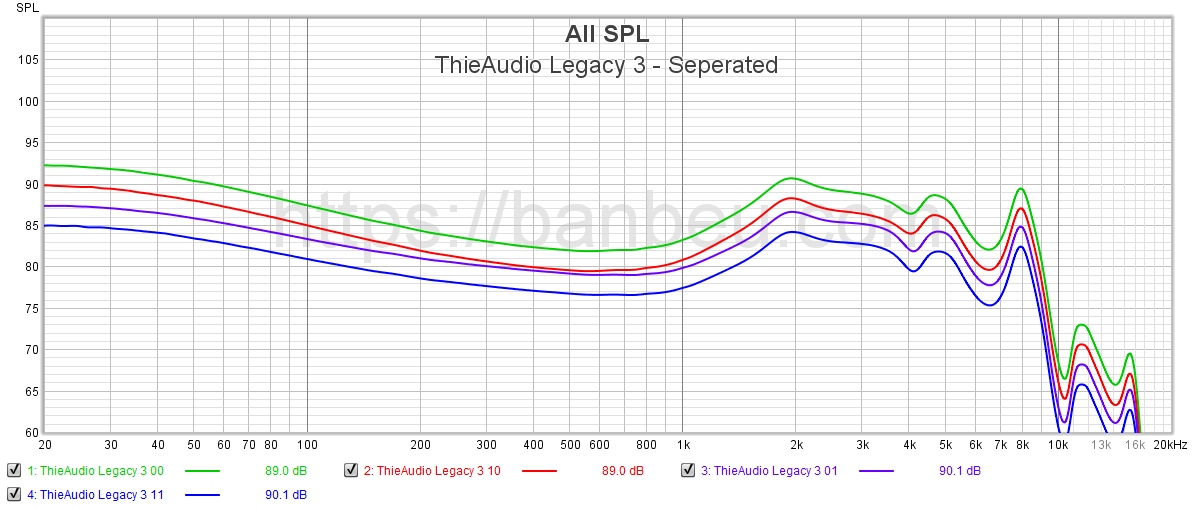Legacy 3: Unit Variation, Measurement Limitations, and Is It Still A Problem?
A few weeks back, I reviewed the Thieaudio Legacy 3
Universal in-ear monitor and gave it a generally positive review, stating that
it was one of the most pleasantly tuned IEMs I’ve heard at the asking price of
$119 and it’s two main issues were treble extension and whether or not
consistency of tuning was still a problem.
I had originally bought a set a couple months back and found channel
mismatch between the left and right channels. I then got a new set replacement and while
the L/R matched, the tuning was also different enough than either the L/R on my
first set that I was a little confused as to what was the real tuning. I
mentioned the issue to Linsoul, who own the brand, and made them aware of my findings after my first set was found to be “broken.”
 |
| Old Measurement (Orange) vs New Measurement (Red) |
After seeing some other measurements from other
reviewers like Crinacle, Banbeu, and Starlord, and also re-assessing Hawaii BadBoy’s
measurements, I decided to run a poll on Head-Fi. This was because I noticed that my first unit had a measurement on the left channel, shown in orange in the above graph, that was similar to HBB's graphed measurements from his review. He happened to have the first or earliest units. My newer graph from my replacement with a newer serial number was much more in-line with the string of measured IEMs that arrived around the same time my new set did, and was actually pretty close to the original unit's right channel sans the elevated bass of that unit.
I asked the forum members on Head-Fi to provide their serial number of their unit, as well as listen to various test tones at 3KHz and 4KHz and 4.5KHz to see if there was a big change in audible volume between the test tones.
If the units sounded fainter at 4 and 4.5KHz than at 3KHz, then it more than likely matched the units measured by Hawaii Bad Boy and one of the sides I had on my first set, which I found to sound very medicore, and also did not match the newer sets that I received and compare similarly to other measurements out in the wild.
Just to be clear, this test was all user-hearing based, however the measured delta between a 3KHz and 4KHz test tone of 5 dB should be very audible. The difference between 3KHz and 4.5KHz should be audible on either set, however on my suspected "older tuning," this change should be going from loud to almost quiet as it's at or over 10dB difference. 10 dB difference equates to double the volume difference in perceived listening.
Head-Fi Poll Test
I asked the forum members on Head-Fi to provide their serial number of their unit, as well as listen to various test tones at 3KHz and 4KHz and 4.5KHz to see if there was a big change in audible volume between the test tones.
If the units sounded fainter at 4 and 4.5KHz than at 3KHz, then it more than likely matched the units measured by Hawaii Bad Boy and one of the sides I had on my first set, which I found to sound very medicore, and also did not match the newer sets that I received and compare similarly to other measurements out in the wild.
Just to be clear, this test was all user-hearing based, however the measured delta between a 3KHz and 4KHz test tone of 5 dB should be very audible. The difference between 3KHz and 4.5KHz should be audible on either set, however on my suspected "older tuning," this change should be going from loud to almost quiet as it's at or over 10dB difference. 10 dB difference equates to double the volume difference in perceived listening.
 |
| Thieaudio Marketing Material |
 |
| Hawaii Badboy/Bad Boy Good Audio Reviews |
 |
| In-Ear Fidelity/Crinacle |
 |
| Banbeu |
After polling a dozen
or so people on Head-Fi, it seems like most of the unit variation issues seemed
to go away with higher serial numbers (for example over 180 – as a guess). Everyone,
besides one other reviewer, Precogvision, said that they did not hear a shift
in volume after listening to the test tones.
That’s good!
Unfortunately, there may have been some earlier units with variation or just a revision done to the cross-overs to produce a new sound signature in that area. Precogvision was loaned a set with a lower serial number and he did hear an audible volume difference and also did not rank this IEM favorably.
From this variation I've seen in the lower treble (3 to 6 KHz range), I think there were possibly two unit tunings out there, with very early sets with a massive dip of -10dB across this range, while newer sets have a much more subtle and smoother dip of only -3 to -5 dB. Earlier units would have been what I measured on my first set and what HBB reviewed, while later ones may have come from the batch that Crinacle and Banbeu reviewed on their respective sites.
Disclaimer on Measurements -- One thing to consider is how accurate or how comparable measurements are to one another. I wrote an article covering the limitations of the IEM measurement systems here: https://www.audiodiscourse.com/2020/07/measurements-and-limitations.html
That’s good!
Unfortunately, there may have been some earlier units with variation or just a revision done to the cross-overs to produce a new sound signature in that area. Precogvision was loaned a set with a lower serial number and he did hear an audible volume difference and also did not rank this IEM favorably.
From this variation I've seen in the lower treble (3 to 6 KHz range), I think there were possibly two unit tunings out there, with very early sets with a massive dip of -10dB across this range, while newer sets have a much more subtle and smoother dip of only -3 to -5 dB. Earlier units would have been what I measured on my first set and what HBB reviewed, while later ones may have come from the batch that Crinacle and Banbeu reviewed on their respective sites.
Disclaimer on Measurements -- One thing to consider is how accurate or how comparable measurements are to one another. I wrote an article covering the limitations of the IEM measurement systems here: https://www.audiodiscourse.com/2020/07/measurements-and-limitations.html
Another note about what I am comparing -- I talk to the measuring community often, and the graphs posted here are from users who all own the same type of coupler -- an IEC711 style coupler. I did, however, move on with a newer version of it and it mostly measures the same, albeit with some resonance differences past 8KHz. That, for the most part, doesn't really affect the rest of the measurements and those are actually not shown here.
Treble and Treble Extension
One thing I've heard in the forums, discord, and other places in the community is the lack of treble extension in this unit. For the universal set, I hear this same lack of treble extension. It's pretty common for many IEMs, especially under $500 or even $1K to lack treble extension past 8 or 9KHz. Most instruments do not extend past this frequency anyway, and some people may not even care or know what to hear, especially if you do not typically hear acoustic live instruments and are only used to hearing out of headphones or IEMs.
As a reference, this chart was made many years ago by the Independent Recording Network and is a nice guide to see where base and harmonic frequencies lie for each instrument. An interactive version can be found here: https://alexiy.nl/eq/

We also discussed about treble extension in one of our earlier podcasts:
As a reference, this chart was made many years ago by the Independent Recording Network and is a nice guide to see where base and harmonic frequencies lie for each instrument. An interactive version can be found here: https://alexiy.nl/eq/

We also discussed about treble extension in one of our earlier podcasts:
Treble, as this relates to the Legacy 3
I've seen several comments including my own about how the Legacy 3 lacks treble extension, and I do think that the UNIVERSAL version does. Various reviewers and owners have commented on this, and I don't think it's related to quality control. It's seen in the measurements. There really isn't a lot of treble beyond 8-9KHz on this IEM in the universal form, looking back at every measurement to date, including Thieaudio's own set. That does not mean that there's "no treble" but it does mean that it's not very audible.
One must also take into account the accuracy of measurements like I discussed in the previous article linked above. I have tested this by listening to test tones at various frequencies and while still audible at some higher frequencies, it's very muted at best.
One must also take into account the accuracy of measurements like I discussed in the previous article linked above. I have tested this by listening to test tones at various frequencies and while still audible at some higher frequencies, it's very muted at best.
In my CIEM review of this IEM, I will address this in more detail as treble extension actually does exist and sounds pretty nice. But that requires a deeper and custom fit to shine out, and it's measurable.
So, back to this quick topic. I do not think quality control is an issue when it comes to treble extension. It just lacks it in the universal fit. It's shown in every measurement to date that it doesn't have any real rise there that are seen in some other IEMs, and typically ones that cost a bit more. That gives the Legacy 3 a duller sound when it comes to specific instruments like how cymbals and violins resonate. Having that extra treble frequency audible allows those harmonics to fully reveal themselves, and not sound muted and dampened.
If you happen to somehow wear this deep enough where treble extension is audible, that's great, but I think the vast majority of users will not be able to hear it very clearly.
This is not to be confused with treble in general also. Treble is a large range that starts at around 3 to 5KHz (depending on who you ask) and goes up past 20KHz, with 20Khz the upper end of human hearing, and with many people not being able to hear below this threshold.
The Legacy 3 has treble, as shown in the rises at 3-4KHz and 6-8KHz in every unit measured. There is some discrepancy whether the older units had much treble between 3KHz and 5Khz, as mentioned earlier, but they all show this lower and mid-treble fine. It's the lack of upper treble, past 9-10Khz that many find lacking, and this again, is measureable and I do not believe is related to any quality control issues that may be similar to the ones I had in my early unit (again, discussed above).
So, conclusions?
Well, I don’t really have any concrete evidence to give, but I can speculate that perhaps a few units early on either had different tuning that had a bigger dip in the 3-5 KHz region, which was shown in the graph by Hawaii Bad Boy early on, and also seen in one of the channels of my first set, and later was revised to reduce that dip...
-OR-
It's hard to really say if there was a tuning change and if there was, at what serial number, because the sample of polled answers was small and most people had later serial numbers.
It does seem that based on a very small sample size on Head-Fi, that many people do have the tuning that some reviewers and myself also have, so that’s a good thing, as I do think that the universal is a nice sounding IEM that does lack some special sauce that makes it perform at the $1000 range, but it is quite enjoyable at the $119 asking price.
My CIEM review is coming soon, and, sneak peek, it's even better.
My CIEM review is coming soon, and, sneak peek, it's even better.
Reference:
Head-Fi Experiment: https://www.head-fi.org/threads/thieaudio-legacy-3.930478/post-15703017
Thieaudio Legacy 3 Review: https://www.audiodiscourse.com/2020/06/thieaudio-legacy-3-and-voyager-3-review.html
Thieaudio Legacy 3 Review: https://www.audiodiscourse.com/2020/06/thieaudio-legacy-3-and-voyager-3-review.html
--
View the product ratings on
Antdroid's IEM Ranking List and/or Antdroid's Headphone Ranking List


i am still waiting on my custom unit of this iem. It will be interesting to see how much of a difference a custom affect eh sound quality, much like some people reported lower treble emphasis with the a12t vs the u12t. Great work
ReplyDelete